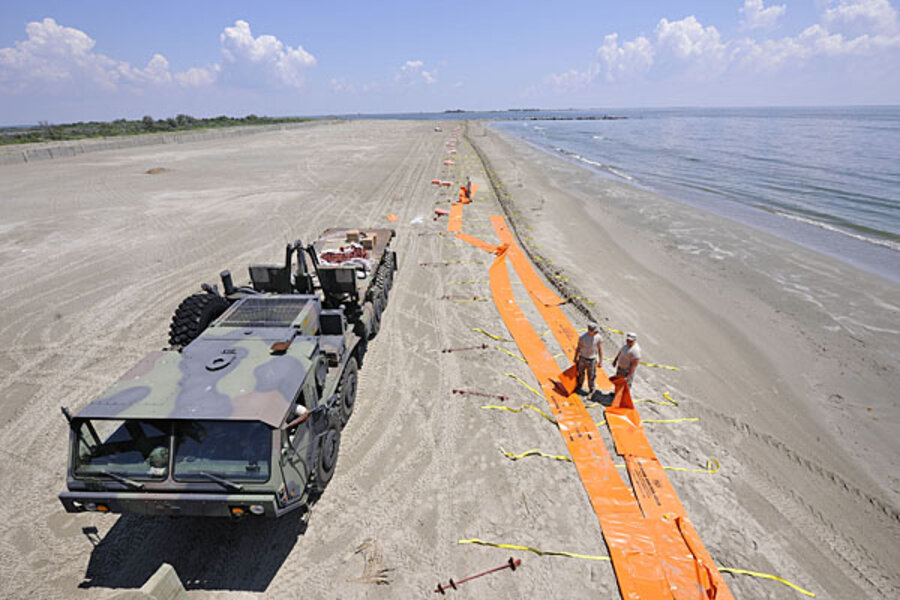Now that 'top kill' has failed, what's next in Gulf oil spill?
Loading...
BP had no sooner proclaimed its “top kill” maneuver a failure than it set in motion what is essentially its Plan D for dealing with the cause of the Gulf oil spill.
Following the “top hat,” the siphon, and “top kill” will be LMRP, the lower marine riser package. The goal of LMRP, like the “top hat” containment dome and the siphon, will be to capture as much leaking oil as possible – not to stop the well.
The “top kill” appeared to be BP’s only feasible means of actually stopping the well until a relief well is finished in August, though BP managing director Bob Dudley said other ideas could emerge.
IN PICTURES: Louisiana oil spill
That leaves BP trying to find ways of keeping the oil – now estimated at as much as 800,000 gallons a day – from spewing into the Gulf of Mexico. The Obama administration, meanwhile, is trying to steel the American public for the possibility that oil leak will continue for at least another two months.
"American people need to know that it is possible we will have oil leaking from this well until August when the relief wells will be finished," presidential adviser Carol Browner told CBS's "Face the Nation" Sunday.
BP's new bid to keep that oil out of the Gulf is LMRP.
LMRP has been described alternately as potentially simpler and more difficult than “top kill.” It involves having one of the bots that gained renown in the “top kill” live feed shear off the riser pipe from the blowout preventer so a new riser pipe – leading to a ship on the surface – can be attached.
The maneuver, which is supposed to take as long as a week, carries several challenges:
1. How do deal with gushing oil
First, BP will have to deal with the fact that the oil and natural gas are gushing from the wellhead with tremendous force. The “top kill” failed because the tens of thousands of pounds of drilling fluid pumped into the well were not enough to subdue the flow of oil and gas.
The new riser will have to be position deftly and precisely by underwater robots under nearly a mile of water. Having to contend with thousands of gallons of oil and gas venting from the well will make the process enormously harder.
BP engineers could try another “top kill” in concert with LMRP – not to kill the well but merely to reduce the pressure of the flow from the pipe while the operation is ongoing. That worked for a time during the "top kill" process.
2. Will it make things worse?
Second, when the bots cut off the riser pipe, they could unleash far more oil. Some scientists believe that the riser pipe, which is lying crumpled on the sea floor, might be acting like a kinked garden hose, obstructing some oil from escaping.
If the riser pipe is sheared off, however, the well will be able to vent oil freely.
If the LMRP process works, much or all of this would be siphoned away. In any case, BP says it believes that the riser pipe is so badly damaged that cutting it off will not result in significantly greater flow.
3. Deep-sea mysteries
Third, BP has once again acknowledged that this process has never been attempted at this depth before. It is a constant refrain, but a legitimate one. The unprecedented depth of this spill makes it the largest unintended experiment in the history of deep-sea oil drilling.
Nothing has ever been done in these conditions before, meaning every attempt involves high levels of uncertainty. Engineers are doubtless learning volumes about how such temperatures and pressures affect their rescue efforts. But they have not, as yet, learned how to overcome them.
Those lessons, however, could prove valuable as BP continues its work, Mr. Dudley said. For instance, the “top hat” containment dome failed when the cold temperatures a mile deep caused methane hydrate crystals to form in the pipe, blocking it.
“We learned some things from the previous [containment dome] cap that we tried that created these hydrates,” Dudley told CNN’s “State of the Union.” “This time, we will circulate warm seawater down around it to prevent that from happening, and our objective is to contain the majority of the oil and gas.”
IN PICTURES: Louisiana oil spill
Related:





